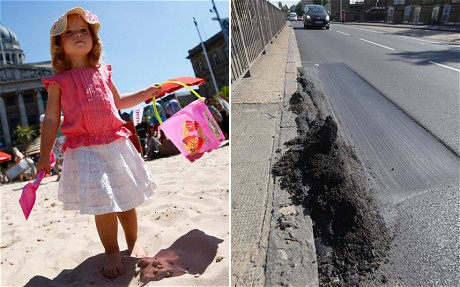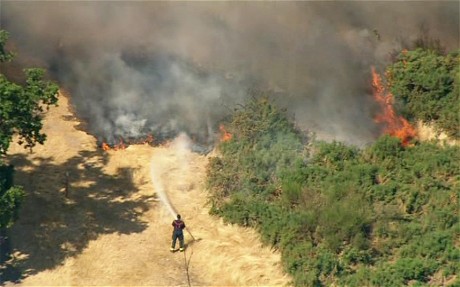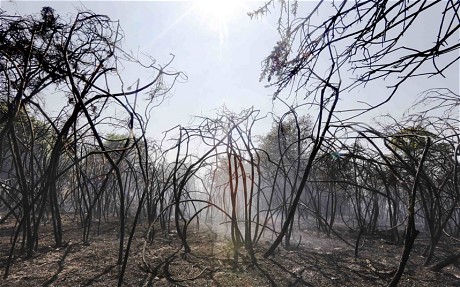With wildfires spreading across the country and even some roads melting, the death toll from Britain's heatwave continues to rise.
A 15-year-old boy is thought to have drowned in a river in the latest heatwave water death.
The teenager was airlifted to hospital after the incident in Roe Valley Country Park near Limavady, Northern Ireland, yesterday afternoon, but died in hospital.
It takes the death toll of water-related deaths to 14 since Britain's longest heatwave for seven years began.
According to Public Health England, 650 people died in the hot weather from July 6 to July 14, with more deaths likely to have added to that tally in recent days.
While the Met Office forecasts temperatures in the east of the UK will cool to 25C on Saturday, it is predicted that next week temperatures could reach up to 35C.
It comes as the black tarmac on a newly-resurfaced £300,000 road in the centre of Cambridge has begun to melt, collecting in a large wave at the side of East Road.
Hampshire county council has also deployed a fleet of gritters to dust the roads to stop surfaces melting.
Motorist James Symth, from Cambridge, said: "I wondered what had happened at first, then I realised the tarmac had melted into this odd shape.
"The heat must have been very intense to have melted the tarmac, I've never seen it happen before."
A spokesman for the local council urged drivers to "take extra care during the current weather", with a week of temperatures of more than 30C.
Last weekend police had to close the clockwise carriageway of the M25 motorway after the surface melted.
Motorists reported a ridge forming in the road while others spoke of cars "ploughing into" the melted road surface.
Meanwhile, fire fighters are dealing with 21 wildfires a day and Met Office weather forecasters have warned of more to come.
A spokesman said: "I can confirm that the advice given to our governmental partners is that there is an elevated risk of fires in the next couple of days."
Soon-to-be harvested crops such as wheat and winter barley are feared to be especially vulnerable to fire.
The number of fires caused by the hot weather is thought to be four times higher than normal.
Some were being treated as arson, including blazes on several different sites across urban heath land in Mannings Heath, Dorset on Tuesday night.
Dorset Fire and Rescue could not confirm the scale of the fire but reports suggested it raged over seven hectares, or the equivalent of 10 football pitches, before being extinguished more than two hours later.
An inferno at Ham Common near Poole in Dorset on Wednesday afternoon also burned for several hours, devastating large swathes of protected nature reserve and forcing sumbathers to flee the beach.
It too was thought to have started deliberately.
The heatwave is set to continue into next week, with temperatures of 30C expected next Monday.

© BBC
Helen Waite, a Met Office forecaster, said it was "not out of the question" that they could even rise as high as 35C as the week went on.
There will be a slight respite over the weekend, however, with the mercury dropping slightly to 28C.
The country experienced the hottest day of the year so far on Wednesday, with highs of 32.2C (90F).
Firefighters in London have already warned of the dangers posed by grass fires.
Yesterday, a blaze burned through grass and gorse the equivalent of four football pitches in Mitcham, south London, before it was brought under control.
London Fire Brigade said it had dealt with twice as many grass fires in this summer's heatwave compared with last year.
It said there had been 21 grass fires a day this July and 1,010 incidents so far this summer.
The fires have mostly been caused by cigarette butts, barbecues or glass bottles.
Avon Fire and Rescue Service said it had dealt with 120 grass, bush and rubbish fires since July 1, compared with 44 in the same period last year.
Disposable barbecues were blamed for many.

© BBC
Hertfordshire Fire and Rescue Service has already been called to 111 incidents involving crops, grass and the open countryside since the start of July, compared to 28 calls in the same period last year.
A spokesman for the Highways Agency said their roads should withstand temperatures of -15C to 60C.
Fire crews were battling two grass fires in Leytonstone, East London, this afternoon.
Eight engines and 60 firefighters were sent to tackle one blaze, and six engines to another.
A London Fire Brigade spokeswoman said it was not clear how the fires started, but warned the public to make sure they putting out cigarettes and barbecues properly near grass areas.

© BBCSmoke rises from shrubs and trees after a fire on Mitcham Common in south London
The brigade said they are dealing with the worst grass fires since 2006, as temperatures peaked at 29 degrees today.
There were 37 grass fires in a 24 hour period, ending yesterday afternoon, though bosses insist they can cope, a spokeswoman said.
There have been nearly 2000 grass fires this year, though that number is set to rise in the next few days, the spokewoman added.
London Fire Brigade's Head of Operations, Prevention and Response, Dave Brown said: "We're attending the highest number of grass fires since 2006 but we are more than able to cope with every incident in London.
"Grass fires can cause a great deal of damage to open spaces and wildlife, and can be avoided by making sure that cigarettes and barbecues are extinguished properly, and that glass bottles are disposed of carefully."
It took firefighters an hour to bring a grass fire the size of three football pitches on Mitcham Common under control yesterday, the biggest so far this year.
Reader Comments
to our Newsletter